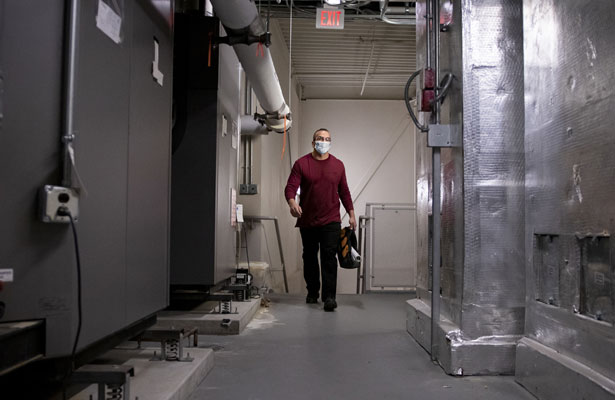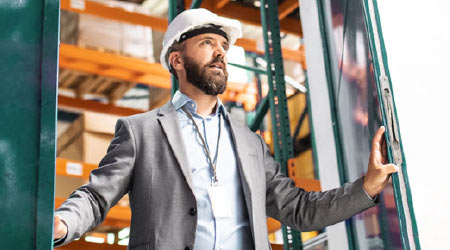SPONSORED
National Grid - Branded Feature
Exploring the Effects on Energy Efficiency as Buildings Reopen During COVID-19
Open up to new possibilities for healthier, safer work environments. LEARN MORE
As an employer, reopening your office space during the coronavirus (COVID-19) pandemic requires careful planning and coordination because naturally, the health and safety of your employees and customers is your number one concern.
Whether you work at a school, manufacturing plant, restaurant, mall, multifamily facility or office building, there are many factors to consider when it comes to cleanliness and safety.
In addition to closely following your state’s requirements, such as tracking employees in the office, staggering shifts, taking temperatures, or using masks and other safety equipment depending on the workplace, there is valuable guidance and recommendations provided by the Center for Disease Control and Prevention (CDC) and the American Society of Heating, Refrigerating and Air-Conditioning Engineers (ASRAE).
A resource page developed by the CDC for employers as they update the HVAC systems in their offices includes tips for ensuring the building is ready for occupancy and recommendations for protecting workers from the virus. It also provides special considerations depending on the type of facility you work in.
If energy efficiency has been a priority for your business, you will find that these recommendations from the CDC and ASHRAE suggest an approach that prioritizes health and safety at the expense of energy efficiency within the building. That means a temporary change in the approach to how you manage energy use in your building, since health and safety is priority.
The following tips can ensure that in the long term, you are protecting your employees, customers and vendors, but remaining as energy efficient as possible in the process.
Optimize Air Ventilation
Many businesses have made significant investments over the years on demand control ventilation, a useful system that automatically reduces outdoor air intake when the building is unoccupied. The system is tied to the direct digital controls of an HVAC system, saving businesses that have made the investment thousands of dollars in energy costs.
The challenge is that under the new guidelines, the recommendation is to increase the percentage of outdoor air to potentially as high as 100 percent. This means the demand control ventilation controls need to be disabled and that natural ventilation from safely opened windows and doors take priority.
Air changes are healthy. Many gyms do this already since there is more humidity and airborne pollutants to remove. The challenge is that these systems are not naturally designed to bring in outside air in the summer when it is hot and humid. In order to follow the guidelines, your system will be using more energy.
The CDC recommends improving central air filtration using filters with a minimum efficiency reporting value (MERV) of 13 or 14. This makes sense as these filters do an excellent job of keeping particulate matter out of the air and, at 2.5 microns wide, they also filter out virus carriers and dehumidify the workplace more effectively.
At the same time, these types of filters can significantly add resistance to the air flow, leading to increased energy usage in the system and pressure in the duct system. It could also lead to some workplace discomfort.
This means that businesses may want to develop staggered work schedules with fewer people in the facility on any given day. Having fewer people in the building decreases energy usage and offsets the energy increases that come inherently with following the CDC ventilation guidelines.
Building maintenance should not go unnoticed. In fact, it should be prioritized as mistakes can be easily made or overlooked in these times. Changing a MERV 13 or 14 filter every two to three months is recommended in order to avoid the high pressure caused by air flow resistance.
Air purifiers that use portable high efficiency particulate air (HEPA) filters can help remove particles from indoor air that may cause allergies, such as pollen or dust. Using an air purifier can help mitigate allergy symptoms and increase employee comfort throughout the building.
While this is an increased energy cost, there are energy efficient options for portable air purifiers that can help to minimize the expense. For example, ENERGY STAR purifiers are nearly 60 percent more energy efficient than traditional models, as long as the HEPA filters are replaced every three months.
The CDC also asks businesses to consider using ultraviolet germicidal irradiation (UVGI) lighting to help “inactivate” the virus. Primarily used in healthcare facilities and labs, this type of lighting can only be used when the facility or section of the building is unoccupied. Portable options are available in the market and the light can be controlled remotely.
A UVGI light also consumes a large amount of energy. While it is effective at “inactivating viruses,” there are some things to consider before purchasing or using it. Doing some research on whether this makes sense for your business would be valuable before making a decision.

Manage to save money – While a potentially costly investment during these challenging times, upgrading to an Energy Management System can transform the way you manage and consume energy across your facility. They integrate seamlessly with your existing building management systems, and pay for themselves in just a few years by dramatically lowering your energy and equipment maintenance cost. LEARN MORE
Take Meticulous Notes
Most businesses already do a good job of taking stock of their maintenance and emergency medical services programs in their buildings. Good maintenance operations save energy, but when implementing the CDC guidelines and state requirements as you reopen, many of your energy-efficiency initiatives may have to go on hold to ensure health and safety.
This means that you should take meticulous notes of all the changes you make in your HVAC system. You should note the settings before the changes, so you can get your facility back to the energy-efficiency settings as soon as pandemic concerns have passed.
All too often when efficiency settings are turned off for maintenance or a unique need, a variable-speed fan, for example, could be running at 100 percent for years when it isn’t supposed to be doing so. Taking meticulous notes of all your settings, from dampers to heat recovery units and demand control ventilation, will help to avoid inadvertent start-up mistakes.
Simple Energy Savings Tips
The COVID-19 pandemic has been a challenging time for most businesses. It isn’t surprising that many organizations that were planning to make significant energy efficiency capital investments may have had to shift priorities at this time and put those off for a few years.
Of course, you’re still looking for ways to keep your energy costs down as much as possible. Here are some additional simple and cost-effective ways to save:
- Use LED bulbs and turn off lights. Energy-efficient light bulbs use 25 to 80 percent less energy than traditional bulbs and last three to 25 times longer, but nothing will save money more on lights than turning them off when the space is unoccupied.
- Install programmable thermostats. Energy bills can reduce as much as 10 percent annually on heating and cooling by turning thermostats back seven to 10 degrees Fahrenheit for eight hours a day from its normal setting. Installing a programmable thermostat that lowers the setting in an unoccupied space can make a big difference.
- Invest in insulation. Insulation is another effective way to enhance workplace comfort. That’s because insulation makes it harder for the heat to escape and avoids drafts in the winter. It also can keep a workplace cooler in the summer and prevent condensation which later results in mold or moisture issues.
- Utilize advanced power strips. A high percentage of electricity could be used by devices that are plugged in 24 hours a day, even when they are off. Computers, televisions, DVD players, modems, cable boxes, cordless phones, radios, printers, chargers and more can consume small volume of watts when plugged in but not in use. Of course, no one wants to simply unplug their electronics every day. Instead, electronics can be “unplugged” with a remote control or “instant on” features through an advanced power strip.
- Move equipment away from floor vents. Floor vents blocked by equipment and furniture require up to 25 percent more energy to distribute air.

Energy-saving tips for tough times – We get it. As buildings get back to the business of making money, you may not have the budget, or the time, to undertake largescale energy-efficiency upgrades. Until that time comes, we can help you keep energy costs down and health, comfort and productivity up with some simple energy-saving tips that your facilities staff can perform. LEARN MORE
Office Space Redesigns
Not only are we seeing businesses applying new health and safety standards in terms of personal protective equipment (PPE) and increased disinfecting of surfaces, but we’re also seeing businesses looking to redesign their spaces to promote safe environments for employees and customers.
For example, the recent trend of open-concept floor plans, which eliminate cubical walls to increase capacity for workspaces, may be a thing of the past. Some businesses are looking at reintroducing high cubicle walls, ensuring six feet or more between workspaces, and installing touch-free fixtures and equipment.
If your workplace goes down this path, consider your lighting and air circulation and quality. Lack of lighting due to high walls can sometimes force employees to use personal lamps. Furthermore, tall partitions can change the characteristics HVAC distribution system, leading to poor air circulation and quality, especially when new rooms are added. When major changes are made, consider rebalancing the distribution system to ensure that air handler speeds are addressed and that supply and return air is properly balanced.
For many offices, there are greater number of employees working from home, therefore less people occupying the office on any given day. Providing more room to help promote social distancing without the need to reconfigure the facility completely.
Conducting due diligence to understand what the daily occupancy of the facility will look like in comparison to the size of the building can help you to understand if simply spreading out the workspaces is enough or if adding those partitions is necessary.
Being aware of these challenges in advance can help you prepare for whichever design best fits your facility and may even help you develop a plan for any future crisis we may face.
Consider Financing Resources for Energy Efficiency Projects
Becoming energy efficient is a strong priority for many, if not most building owners and companies. If your business requires a significant capital investment to keep running smoothly, there are financing and incentive options available to help during the challenging times of the COVID-19 pandemic.
Depending on the region where you live, utilities have partnered with banks, non-profits and government organizations to help finance capital projects. Some of these partnerships offer low-interest loan options to help finance energy efficiency projects. Contacting your utility to find out what options are available may be a good idea.
Many utilities provide a large portion of the expenses needed to upgrade to energy efficient lighting and controls, refrigeration, HVAC, compressed air and more. This varies based on fuel type, utility and region.

Business Assistance during COVID-19 – We’re here to support your business. Find out about bill payment options, energy-efficiency strategies, tips, resources and more. LEARN MORE
Conclusion
Health and safety of employees is certainly the number one concern of all businesses, but they should be aware that increased energy costs will be a byproduct of complying with CDC and ASHRAE guidelines on ventilation. There are things companies can do at little to no cost to save as much as possible on energy usage. Taking the time to understand all the variables in your specific building situation will help your organization make informed decisions that are best for the health and safety of your employees and your bottom-line.
Christina Kovage is a Senior Marketer at National Grid. To learn how doors are opening to new possibilities for your business during this pandemic, visit ngrid.com/biz.











